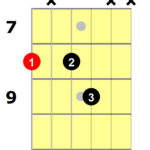Active Guitar Pickups have carved a significant niche in the guitar world, especially over the last three decades. While passive pickups remain the traditional choice, active pickups, pioneered by EMG in the 1980s, offer a distinct set of sonic characteristics and advantages tailored to the needs of modern guitarists. At their core, active pickups share the fundamental design of wire-wrapped magnets with their passive counterparts, but their construction and underlying technology diverge in crucial ways.
One prime example is EMG’s approach, which utilizes significantly fewer wire coils compared to typical passive pickups. This design choice results in a naturally lower output signal, which translates to a remarkably quiet and virtually noise-free performance. To compensate for this lower inherent output and achieve a usable signal level, active pickups incorporate a built-in preamp. This preamp, powered by a 9V battery, actively boosts the signal, giving active pickups their characteristic мощный and articulate sound.
While passive pickup technology has remained relatively consistent over the years, active pickups have continually evolved to meet the demands of contemporary players. Fishman‘s Fluence pickups stand as a testament to this innovation. Acclaimed for their exceptional clarity, noise-free operation, and versatile multi-voice capabilities, Fluence pickups represent a departure from traditional designs. Instead of relying on wire-wrapped magnets, Fishman employs advanced circuit board manufacturing techniques and a layered pickup core with multiple coils. The adoption of Fishman Fluence pickups by renowned guitarists like Tosin Abasi, Greg Koch, and Devin Townsend underscores their quality and relevance in today’s music scene.
The Sonic Advantages of Active Pickups
Active pickups offer a range of benefits that cater to specific playing styles and sonic preferences. One notable advantage stems from their design with fewer wire wraps, resulting in a weaker magnetic pull on the guitar strings. While seemingly counterintuitive, this reduced magnetic force allows the strings to vibrate more freely and for a longer duration, leading to enhanced sustain. Some guitarists also believe that this reduced magnetic pull contributes to more accurate intonation on guitars equipped with active pickups.
The integrated preamp in active pickups is a key factor in their higher output compared to passive pickups. This increased output makes them exceptionally well-suited for high-gain applications, where мощный and saturated tones are desired. Simultaneously, the inherently lower noise floor of active pickups minimizes unwanted hiss and hum, resulting in a cleaner and more focused high-gain sound. While EMG and Fishman pickups are often associated with metal genres due to these characteristics, it’s important to note that both companies also produce single-coil active pickups, demonstrating their versatility. Even legendary guitarists like David Gilmour have utilized EMG pickups in their Stratocasters for extended periods, showcasing the broader appeal of active technology.
Guitarists using active pickups often appreciate the enhanced responsiveness of their guitar’s volume and tone controls. Active pickups, with their lower impedance, mitigate the common “volume roll-off” issue experienced with passive pickups. In passive circuits, reducing the volume can often darken the tone alongside decreasing the loudness. However, with active pickups, the volume pot operates more linearly, allowing for volume adjustments without drastically altering the fundamental tone. While some players appreciate the tone-darkening effect of passive volume circuits, active pickups offer a more transparent and predictable volume control.
Furthermore, the lower impedance of active pickups provides advantages when using longer guitar cables. Long cable runs can introduce capacitance, leading to treble frequencies being attenuated, resulting in signal degradation. To combat this, guitarists often employ buffer pedals to convert the high impedance signal to a low impedance signal, preserving high-end frequencies. Active pickups, with their inherent low-impedance design, are less susceptible to treble loss even with longer cables, potentially eliminating the need for a separate buffer pedal in the signal chain.
Potential Drawbacks to Consider
Despite their numerous advantages, active pickups also come with certain considerations that might be seen as drawbacks by some players. The most prominent of these is the necessity for batteries. Active pickups require a 9V battery to power their onboard preamp, which introduces the potential for battery depletion. Unlike passive pickups, active systems will cease to function when the battery is drained. While battery life for brands like EMG is typically extensive, lasting for hundreds of hours, the lack of a low-battery warning can be inconvenient. Fishman addresses this concern in their Fluence range by offering rechargeable options with micro-USB connectors, providing a more sustainable power solution. Furthermore, accommodating a 9V battery and its clip requires sufficient space within the guitar’s electronics cavity, which might be a limiting factor in some instruments.
Another significant consideration arises when switching from passive to active pickups. Due to the impedance differences and the preamp requirement, a simple pickup swap is not possible. Converting to active pickups necessitates replacing the entire electronic circuitry within the guitar to ensure compatibility. This includes not only the pickups themselves but also potentiometers, jacks, and wiring.
Consequently, the transition to active pickups can become a more complex and potentially expensive undertaking compared to passive pickup replacements. The need for additional components and potentially professional installation can add to the overall cost. However, for many guitarists, the sonic benefits and performance advantages offered by active pickups justify the investment and effort involved in making the switch.

